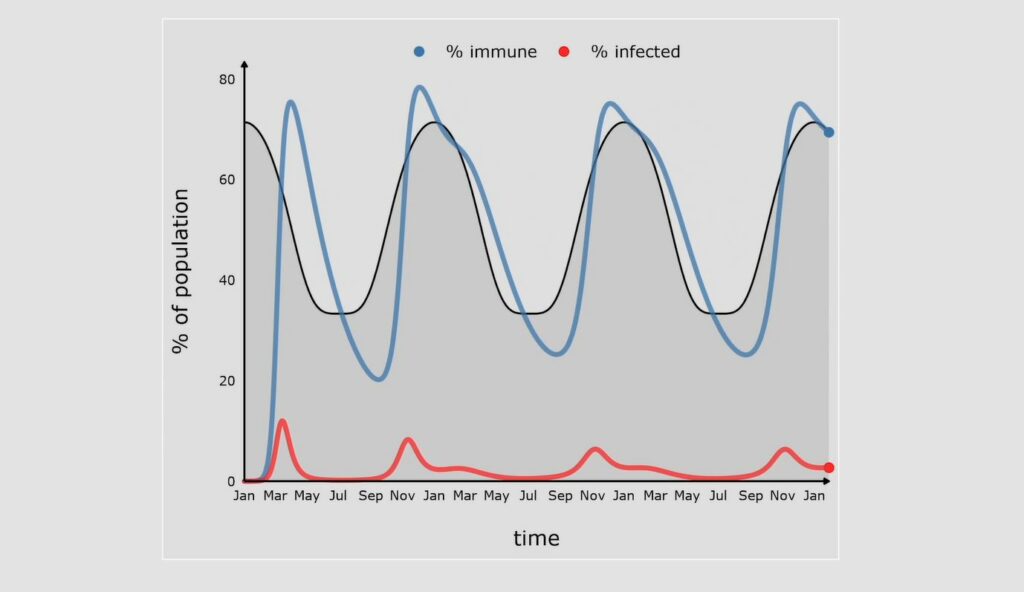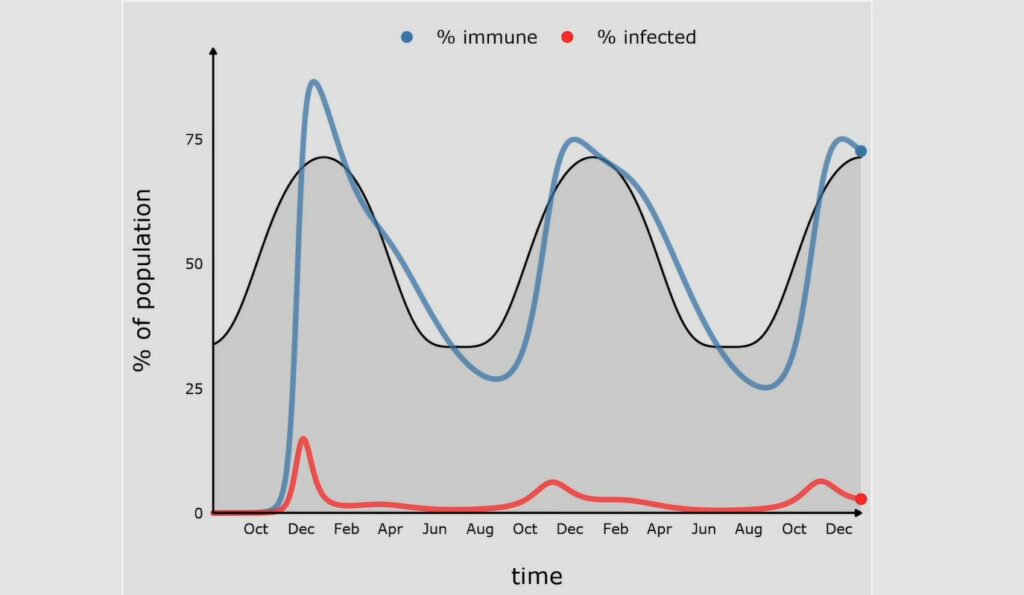CG Mini-Lectures: How seasonality affects the spread of a new virus
Professor Sunetra Gupta explains the concept of herd immunity threshold and how seasonality affects the way a virus spreads.
Transcript
Many viruses are better able to spread at particular times of the year. How does this seasonality in transmission affect the way that a new virus will spread through the population?
In order to answer this question, we need to first understand the concept of a herd immunity threshold.
Herd immunity refers to the accumulation of immune individuals in a population.
When a new virus enters a population, it muddles along for a while, and then it really starts to take off, as you can see here in this red line, which is tracking the proportion of the population infected by this new virus. And as you can see, after a while, this peaks, and the proportion infected starts to come down again.

Now why does that happen? This is because once people recover from infection, they become immune, and this means that the virus starts to run out of susceptible people to infect. The blue line here is showing you how the proportion immune is growing at the same time.
There comes a point when the proportion of the population immune is high enough that the rate of growth of infection become negative, and that’s when the virus hits peak and the infections start to decline. This occurs when the proportion of the population immune has crossed a threshold, which is known as the herd immunity threshold. That herd immunity threshold is determined by the fundamental transmissibility of the pathogen itself.
If there’s no loss of immunity, the proportion immune, this blue line, will stay above the herd immunity threshold, which means that no new epidemics can occur and the virus will die out.

In reality the proportion immune will decline with time. For viruses like measles which give you lifelong immunity against infection, this will happen at a very slow pace. For many other viruses, like the coronaviruses, immunity against infection declines on a much shorter timescale. And as soon as it dips below the herd immunity threshold, infections will start to climb again, and we will see a second wave.

The second wave is smaller than the first wave because this time the gap between the proportion immune and the herd immunity threshold is much smaller and therefore more quickly closed.
The other thing to note about the second wave is that many infections are actually reinfections, so people who’ve lost immunity are becoming infected again. What this means is that the rates of severe disease and death are likely much lower, because people will retain the ability to resist disease even though they have lost their ability to resist infection.
Further waves will occur when the proportion immune falls below the herd immunity threshold again, but the gaps will get smaller and smaller and the waves will get smaller and smaller until they sort of flatten out at an endemic equilibrium.

Now let’s go back to our original question. What happens if there is seasonality in transmission?
As I’ve just explained, the herd immunity threshold is strongly dependent on the transmissibility of the virus, so as the transmissibility goes up and down with seasons, so will the herd immunity threshold. And that’s what’s show here by the gradated area.

So now you see a more complex picture emerging which is the result of an interaction between waning immunity and the changes in the herd immunity threshold.
After the first peak, immunity wanes, but because the herd immunity threshold is also declining it takes longer for the blue line to dip below the herd immunity threshold. And so the next peak is delayed. Eventually this settles into a pattern which is characteristic of the seasonal respiratory viruses which we live with at endemic equilibrium.
Without seasonality it doesn’t make much of a difference at what time of the year the virus arrives. But when you have seasonality in transmission, it makes a really big difference.
A virus that arrives just before peak season will have a very big first wave, because the proportion immune will have to reach a very high herd immunity threshold before we see a decline in infections.

But if the virus arrives in a low season, the first wave could be quite small because the proportion immune only has to reach that lower herd immunity threshold before a turning point occurs.

However, as the herd immunity threshold starts to climb again, we will get a second wave in order to catch up with the new higher herd immunity threshold. And in some instances this could actually be larger than the first wave.
Of course the virus could arrive at different times of the year in different regions of the same country. What that means is lumping all these patterns together can be quite misleading.
Eventually all viruses will reach a state of endemic equilibrium, but their journey to that state from the point of introduction depends crucially on the rate at which infection blocking immunity decays for that particular virus as well as seasonality in transmission.

Sunetra Gupta is Professor of Theoretical Epidemiology in the Department of Zoology, University of Oxford and a member of Collateral Global’s Scientific Advisory Board.
